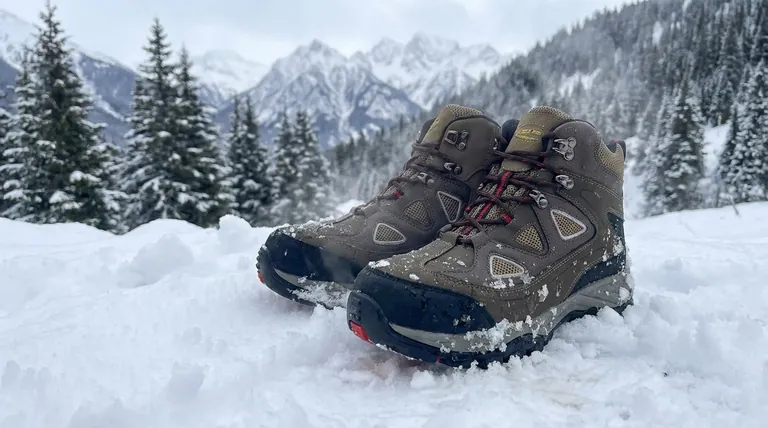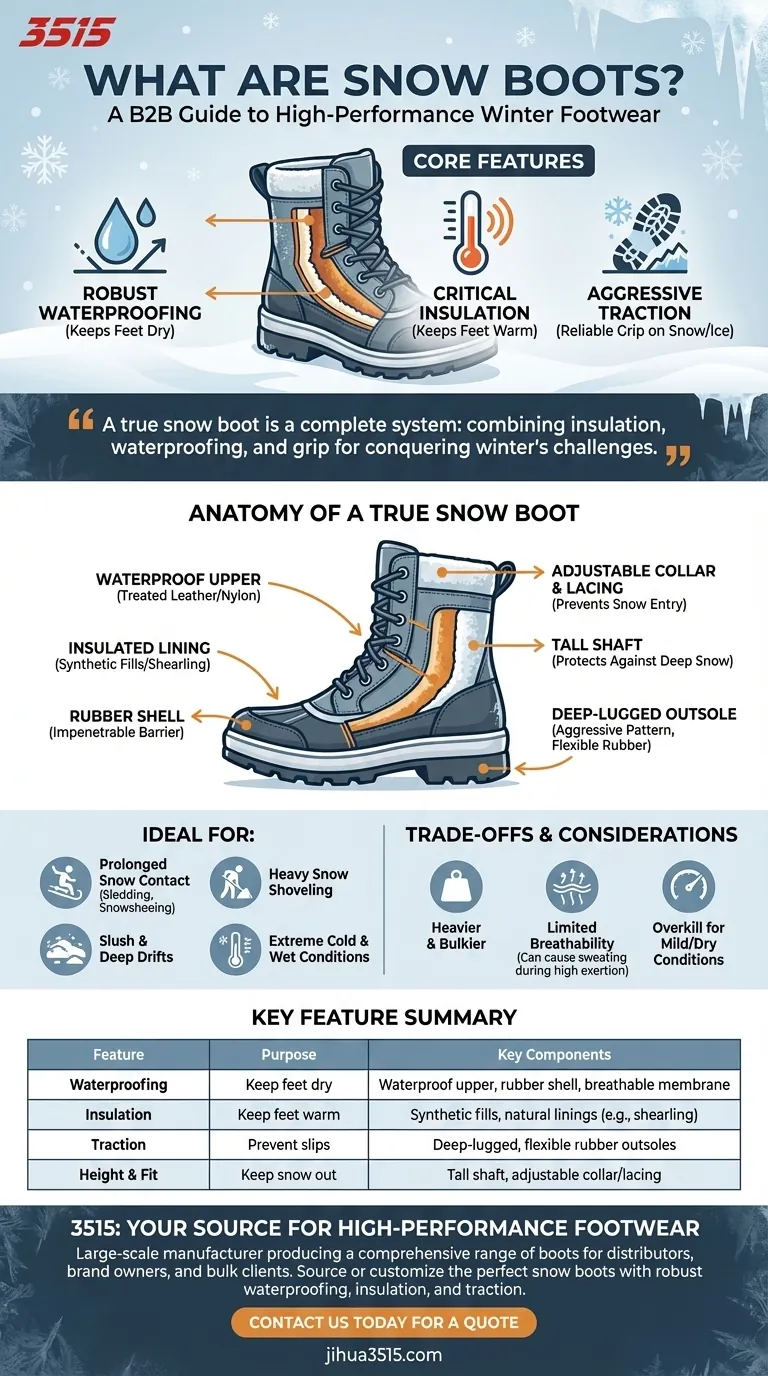At their core, snow boots are specialized footwear engineered to perform in cold, snowy, and wet conditions. They are defined by a trio of essential features: robust waterproofing to keep feet dry, significant insulation to keep them warm, and aggressive sole designs to provide reliable traction on snow and ice. Their primary purpose is to ensure safety and comfort in demanding winter environments.
While many boots offer warmth or water resistance, a true snow boot is a complete system. It combines insulation, waterproofing, and grip into a single tool designed to conquer the unique challenges of snow, slush, and freezing temperatures.

The Anatomy of a True Snow Boot
Understanding what makes a snow boot effective requires looking at its specific components. Each feature serves a critical function in protecting your feet from the elements.
### Waterproofing and Protection
A snow boot’s first line of defense is its ability to keep moisture out. This is typically achieved with a waterproof upper made from materials like treated leather, nylon, or other durable textiles.
The lower portion, or shell, is often made of rubber to create an impenetrable barrier against slush and puddles. Many high-quality boots also include a waterproof, breathable membrane to let sweat vapor escape while blocking external water.
### Insulation for Critical Warmth
Snow boots are built for extreme cold. They feature integrated insulation, sometimes rated for specific temperatures, to trap body heat and keep your feet warm.
Common insulation materials include synthetic fills or natural linings like shearling, which provide excellent thermal properties.
### Traction for Safety on Ice and Snow
The outsole of a snow boot is one of its most critical features. It is designed with deep, widely spaced lugs or treads.
This aggressive pattern bites into snow and provides a stable grip on slippery surfaces, significantly reducing the risk of falls. The rubber is also formulated to remain flexible in freezing temperatures, ensuring consistent traction.
### Height and Adjustability
Snow boots typically have a higher shaft than standard boots. This height prevents deep snow from falling into the boot from the top.
Many models also feature an adjustable collar or lacing system that can be tightened to create a seal around your leg, further protecting you from snow entry during activities like sledding or walking through drifts.
When Snow Boots Are the Right Tool
Snow boots are not all-purpose winter footwear; they are a specific solution for specific problems.
### Ideal Activities and Conditions
These boots excel in activities where you have direct, prolonged contact with snow. This includes recreational activities like snowshoeing, sledding, and outdoor play.
They are also the ideal choice for functional tasks like shoveling heavy snow or navigating unplowed streets covered in deep snow and slush.
### Handling Extreme Cold and Wetness
Their heavy insulation and robust waterproofing make them essential for environments with significant snowfall, slush, mud, and frigid temperatures. In these conditions, keeping your feet warm and dry is not just a matter of comfort but also of safety.
Understanding the Trade-offs
The specialized design of snow boots comes with inherent compromises that make them unsuitable for certain situations.
### Weight and Bulk
The features that make snow boots so effective—thick insulation, rubber shells, and tall shafts—also make them heavier and bulkier than other footwear. This can make them feel cumbersome for long walks on cleared pavement or for everyday wear.
### Limited Breathability
While some models incorporate breathable membranes, the intense focus on waterproofing and insulation can limit a boot's ability to vent moisture. In high-exertion activities, this can lead to sweaty feet, which ironically can become cold once you stop moving.
### Overkill for Mild Conditions
For a cold but dry day, or for navigating light rain or minimal slush, a full-fledged snow boot is often unnecessary. A simpler insulated or water-resistant boot may provide sufficient protection while being significantly more comfortable and lightweight.
Making the Right Choice for Your Needs
Selecting the right winter footwear depends entirely on the conditions you expect to face.
- If your primary focus is recreation in deep snow (sledding, snowshoeing): You need a tall, fully waterproof snow boot with a high level of insulation and an adjustable collar.
- If your primary focus is walking through slushy city streets: A mid-height, waterproof boot with good traction is essential, but extreme temperature ratings may not be necessary.
- If your primary focus is active winter hiking on packed trails: A lighter, more breathable winter hiking boot may be a better choice to manage sweat and reduce fatigue.
Choose the footwear that directly solves the problem presented by your specific winter environment.
Summary Table:
| Feature | Purpose | Key Components |
|---|---|---|
| Waterproofing | Keep feet dry | Waterproof upper, rubber shell, breathable membrane |
| Insulation | Keep feet warm | Synthetic fills, natural linings (e.g., shearling) |
| Traction | Prevent slips on ice/snow | Deep-lugged, flexible rubber outsoles |
| Height & Fit | Keep snow out | Tall shaft, adjustable collar or lacing system |
Need reliable snow boots for your customers?
As a large-scale manufacturer, 3515 produces a comprehensive range of high-performance footwear for distributors, brand owners, and bulk clients. Our production capabilities encompass all types of boots, including specialized snow boots designed with the robust waterproofing, critical insulation, and superior traction detailed in this article.
We can help you source or customize the perfect winter footwear to meet market demand. Contact our team today to discuss your needs and get a quote!
Visual Guide

Related Products
- Safety Footwear Wholesale Manufacturer for Custom OEM/ODM Production
- Wholesale Safety Footwear Manufacturer for Bulk & Custom OEM Orders
- Customizable Anti-Smash Safety Boots for Wholesale & Private Label Manufacturing
- Premium Wholesale Waterproof Safety Boots High Performance Protection for Industrial Markets
- Premium Grain Leather Safety Boots for Bulk Supply
People Also Ask
- Do snake bite boots work? Your Ultimate Guide to Effective Snake Bite Protection
- What are OSHA approved shoes? Understanding the Correct Standards for Workplace Safety
- Is it normal to wear shoes in the house? A Guide to Hygiene, Comfort & Culture
- What do heavy duty boots do? Protect Your Feet in Demanding Work Environments
- What are the cultural perspectives on wearing shoes in the house? A Guide to Home Etiquette & Hygiene



















